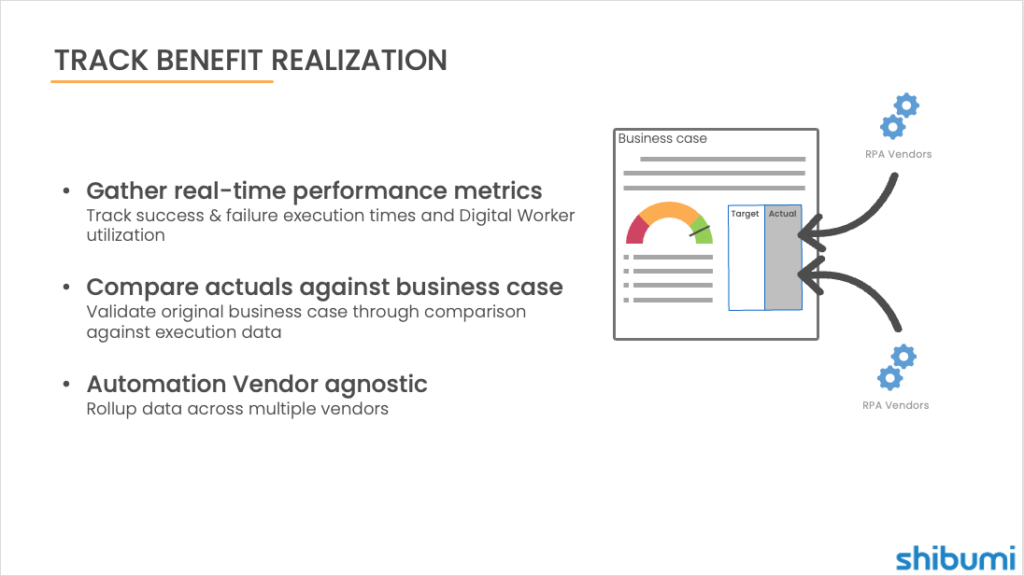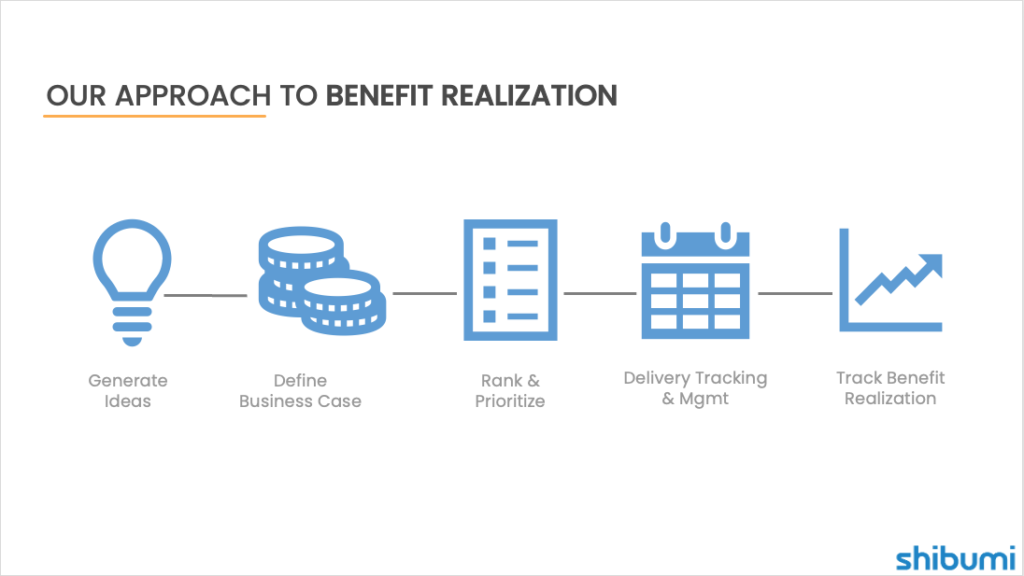Benefits realization is a simple yet powerful concept.
When executed well, this process can create value that long outlasts the projects for which it was designed. However, considering the intricate elements involved in benefits realization, it can often become a complicated workflow in the context of business transformation efforts. Today, only 36% of organizations fully realize project benefits, which means most businesses are leaving value on the table.
In a business landscape full of buzzwords, strategies, and new tools, it can be overwhelming to hone in on what’s right for your business. In this article, we’ll break down benefits realization, including what it is, what the process looks like, and its long-term impact on transformation.
Let’s get into it.
What Is Benefits Realization?
Simply put, benefits realization is the process of making sure that individual projects, and the portfolio overall, actually deliver their anticipated value.
Value takes on a robust meaning. It includes tangible benefits like cost reductions, increased revenue, and faster process times, as well as intangible benefits like employee satisfaction, improved brand recognition, higher customer satisfaction, and operational alignment.
The process involves identifying desired outcomes and then continuously planning, tracking, and managing projects to move toward those goals.
What Does the Benefits Realization Process Look Like?
At first glance, the benefits realization process appears straightforward. It may seem as simple as documenting the connection between projects and the value they provide.
Complexity arises when an organization lacks a reliable platform for monitoring progress. Without a framework for defining, benchmarking, and recording successful outcomes, project benefits can quickly become lost. In these cases, it is nearly impossible to successfully execute a benefits realization program.
As a result, organizations must approach benefits realization with realization management technology that enables confident documentation and analysis of project results.

Why does a project fail to deliver potential benefits?
To understand the true value of benefits realization, it is first necessary to recognize under what circumstances a project may fail to deliver business benefits.
In some cases, a lack of results reflects poor planning from the project’s onset. For example, if a goal exists independent of any strategy that helps each stakeholder work toward that end, desired benefits can go undelivered. Similarly, benefits may be undermined by goals that are unclear, ill-defined or not strongly aligned with the strategic objectives of the larger transformation program. This is most often a result of unclear project management or project leadership.
In other cases, business projects may have a solid framework that is nonetheless poorly executed. This can involve:
- Resourcing issues.
- Too many stakeholders.
- Unmet funding needs.
- Poor change management.
- Limitations imposed by otherwise-useful organizational rules.
Under these circumstances and many others, a commitment to benefits realization can help clarify the connections between projects and results. The insight provided by this process allows each leader and stakeholder to make adjustments as needed, which can lead to stronger projects and more sustainable outcomes.
For example, cost optimization projects require both an effective strategy and keen oversight to create intended benefits. If one element exists without the other, there may be an almost immediate breakdown in communication, expectations and delivery of results, all of which would lead to even less cost control than before. Therefore, strategy and oversight must exist together to produce benefits that last far beyond project completion.
How benefits realization can help
When facing one or more of these obstacles, a project may seem doomed from the beginning. However, benefits realization offers the framework necessary to simplify strategy execution, ensuring each step, task and stakeholder creates measurable value on a managed schedule.

The benefits realization process works by giving organizations the tools to define and measure success. This can be reflected in a variety of benchmarks, including:
- Fulfillment of each expected benefit.
- Equitable resource consumption.
- Avoidance of major delays.
- Effective change management.
- Prevention of significant errors or missteps.
Because of the inherently varied nature of value measurement, one of the earliest tasks in any benefits realization framework is for an organization to visualize its own definition of success. This can involve a review of competitor results, an analysis of previous project successes and failures, utilization of company metrics and data and more.
The overall goal is to implement solutions that measure individual project success as well as contextualize these accomplishments as part of the larger program objective. The longer each benefit of a project continues to create value or create positive business change, the more successful the effort.
What does a benefits realization project look like?
Among other elements, effective benefits realization requires:
- Strategic goals.
- Consistent planning, forecasting and analysis.
- The selection of dependable management and leadership.
- A solid framework designed with actionable goals in mind.
- Building strong connections between the broader initiative, the specific project and each business benefit.
The Project Management Institute broke down successful benefits realization into three detailed, multi-step frameworks. These workflows cover the benefit identification process that must occur at the start of a program, the execution of business project plans, and the management necessary to sustain successfully realized benefits.
A benefits realization plan can look different depending on the project, the scope of each intended benefit, management needs and the strategy of the organization as a whole. To ensure the success of business transformation efforts, it is necessary to approach this framework with the appropriate levels of flexibility.

Benefits realization management
No benefits realization plan exists in a vacuum. Instead, benefits realization management, or BRM, must have an active role in every step of the process, from strategizing to implementation.
Benefits realization management is the process by which project and organizational leaders align their expectations with a project’s potential results. This requires an effective combination of business strategy and available resources, as well as significant energy devoted to ensuring that each intended benefit creates long-term value after project completion. It differs from generalized benefits realization by emphasizing the role of leadership in designing, measuring and implementing the overall framework for a project.
To increase the odds for success in benefits realization, BRM processes must avoid results that harm sustainability or stability. The role of leadership in BRM is to guide each project toward a well-defined benchmark for success while navigating the inherent challenges of the process.
Here are a few examples of ways benefits realization management can create an effective framework for every project:
Resource allocation
A benefits realization plan puts a project’s leadership in control of all available resources. This includes determining the availability and accessibility of those resources, distribution between stakeholders depending on the complexity and breadth of their respective tasks, creation of a framework that discourages overconsumption, and more. This type of careful management greatly reduces the risk of bottlenecks and other efficiency issues, allowing the benefits realization process to take shape.
Budget control
Budget control is one of the most important elements of BRM, but it’s also one of the most complicated. However, with the appropriate framework in place, budget control can become a tool for creating further benefits rather than an obstacle to project success.
For example, effective benefits realization management may involve the creation of dynamic budgets based on priority hierarchies. With this structure, a step or element that comes in under budget can have its excess funds quickly and effectively allocated to the stakeholders most in need, minimizing any competition between teams and maximizing the value of each expected benefit. This ensures that the most critical tasks are treated as such without jeopardizing the integrity of other project elements.
Constant visibility
Visibility is a necessary element in BRM. It’s equally necessary, however, to keep this visibility from becoming available only to project leadership. Instead, to maximize the value of benefits realization, each stakeholder must be at least aware of the tasks surrounding theirs. Utmost transparency should exist for each element directly related to or dependent on a stakeholder’s responsibilities.
Another element of constant visibility from a benefits realization management perspective is avoiding oversaturation. While leadership needs to be aware of every change, challenge, success, and need, stakeholders rarely do, which means too much information could overwhelm or confuse them. To help each team member focus on creating the benefits they’re directly responsible for, leadership can prioritize visibility on a “need-to-know” basis by distributing information based on relevance.
Alignment with the organization’s goals
Projects that become too broad or ambitious may still create benefits, but they will rarely be in line with the benefits realization framework, or with the organization’s goals. To avoid this, benefits realization management must ensure every step of a project is designed with consistent objectives in mind. This often requires refocusing, clarifying expectations, working with stakeholders to refine intent, and more.
However, alignment with organizational goals doesn’t mean that every task must be measured by the same benchmarks for success. BRM also involves goal translation, which means helping stakeholders understand how their smaller objectives relate and contribute to the whole. This gives team members agency over their responsibilities without losing sight of a project’s intended benefits.
Stakeholder engagement and communication
Through every step of a project, one thing remains constant: the need for stakeholder engagement. Benefits realization management gives leadership the ability to unite team members in the pursuit of shared value, all without limiting the creative freedom, reach, or scope of their abilities. This often involves approaches like consistent communication, the celebration of project successes, review of intended benefits, and more.
Realize every project’s full potential
Because any business project can face challenges and benefits realization management must be fast and flexible to keep pace, it is often necessary for organizations to utilize platforms that put success within reach.
Shibumi offers a purpose-built solution designed to provide the necessary insight and analysis to structure effective BRM. Our platform focuses on oversight of wide-ranging, transformational programs. Stretching from an executive view of major achievements to a close evaluation of individual projects, it allows you to measure success based on personalized benchmarks. It also interfaces with existing project management software, providing crystal-clear visibility into project efforts and giving you the tools to confidently realize the benefits of crucial programs.
Finding an experienced, committed and dependable partner to support your business transformation efforts is a vital step toward success. Shibumi understands the complexities of modern transformation programs and offers specialized solutions that empower your key stakeholders, from the boardroom to project managers and key team members. To learn more, request a free demo today.

